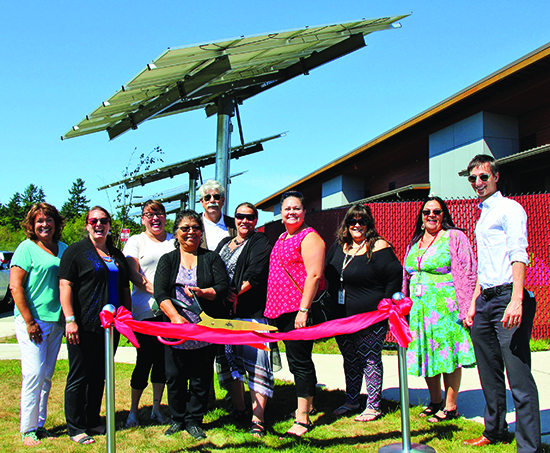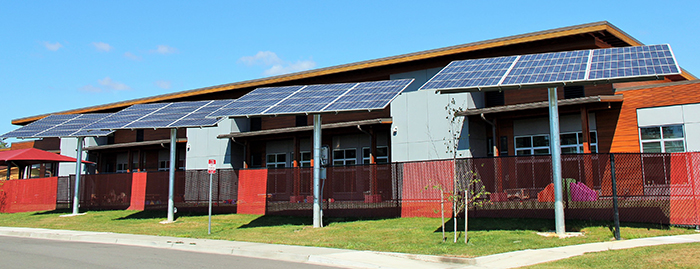By Micheal Rios, Tulalip News
A sunshine celebration ribbon cutting was held by Tulalip tribal leadership on Tuesday, August 15, to honor the many benefits of the Betty J. Taylor Early Learning Academy’s solar energy movement. In partnership with Bonneville Environmental Foundation’s Solar 4R Schools program, four 20’x14’ solar panels were installed at the learning center back in April. Since their installation they have been harnessing the power of sunlight and turning it into electricity to help power the 52,000 square-foot Early Learning Academy,
“We are so excited to be the first tribal facility to go greener,” says Sheryl Fryberg, Director of the Early Learning Academy. “We want our children to learn at a young age the importance of how to make our planet a cleaner, safer place for future generations.”
Overlooking scenic Tulalip Bay, the sunlight absorbing solar panels have a direct sightline to the most powerful source of energy in the solar system, our sun. Making further use of the life-giving and renewable energy source, the solar movement forwards the Tribe’s goals of creating a healthy, sustainable community. There is no loss of air or water quality as a result of increasing the amount of energy now available to the Early Learning Academy. In this respect, making use of renewable energy is highly compatible with Native beliefs, such as living in harmony with nature and protecting the environment.
“This solar panel project is about showing our community what’s possible with solar energy. I’m committed to renewable energy all the way and even have solar panels installed on my home,” states Bonnie Juneau, Tulalip Board of Director. “Solar energy is proven to be effective and reduces our harm to the environment. It’s phenomenal. Going forward, all of our buildings will have south-facing roofs so the panels can harness as much sunlight as possible.
“This project also gives us an opportunity to show our children what exciting things can be achieved with math and science. Teaching them about solar energy at such a young age will only help them in the future. Think about the possibilities, about what one of our children may be able to come up with in 15-20 years. I’m so excited just thinking about what is now possible.”
Indeed, the Early Learning Academy’s children have already begun learning about solar energy in fun and effective ways. Solar 4R Schools program delivers one of the most comprehensive renewable energy STEM education experiences in the nation. Through teacher training, science kits, teacher-generated activities and real-time access to energy generation data from 200+ solar systems nationwide, we are directly empowering the next generation of clean energy leaders.
“The preschool staff are thrilled to be learning new activities to teach our children,” explains Sheryl Fryberg. “They were part of an all-day training to learn how to teach their preschool children energy projects in the classroom. They learned how to build a solar energy car, bake with a solar oven and even make some Crayola shirts with a solar oven. Our children will be learning how to do these projects and we are hoping that it will spark a long term interest in them about how to do their part to save the planet.”
An underlying benefit to the Academy going solar is a reduction in utility costs, which will allow more dollars to be directed toward educational needs. The solar panel array has produced 8,767.4 kWh (kilowatt-hours of electricity) so far. Given that the school has the SNOPud general utility rate of $0.0891/kWh, the solar system has generated approximately $781.18 worth of electricity savings to date.
Located in the lobby of the Early Learning Academy is a very cool information kiosk that gives students, teachers, and visitors an in-depth look into solar electric energy generated by the panels. At any given time one can see live data in a variety of ways. Equivalency results detail the impact of conservation efforts made by using the solar panels. To date, 13,584 pounds of CO2 has been saved which is the equivalent of 14,767 miles driven by an average passenger vehicle, 6,575 pounds of coal burned, or 14.3 barrels of oil consumed.*
For more information on the Academy’s solar panel project please visit http://www.solar4rschools.org/kiosk-betty-j-taylor-early-learning-academy for live data and further renewable benefits.
*Source: https://www.epa.gov/energy/greenhouse-gas-equivalencies-calculator

